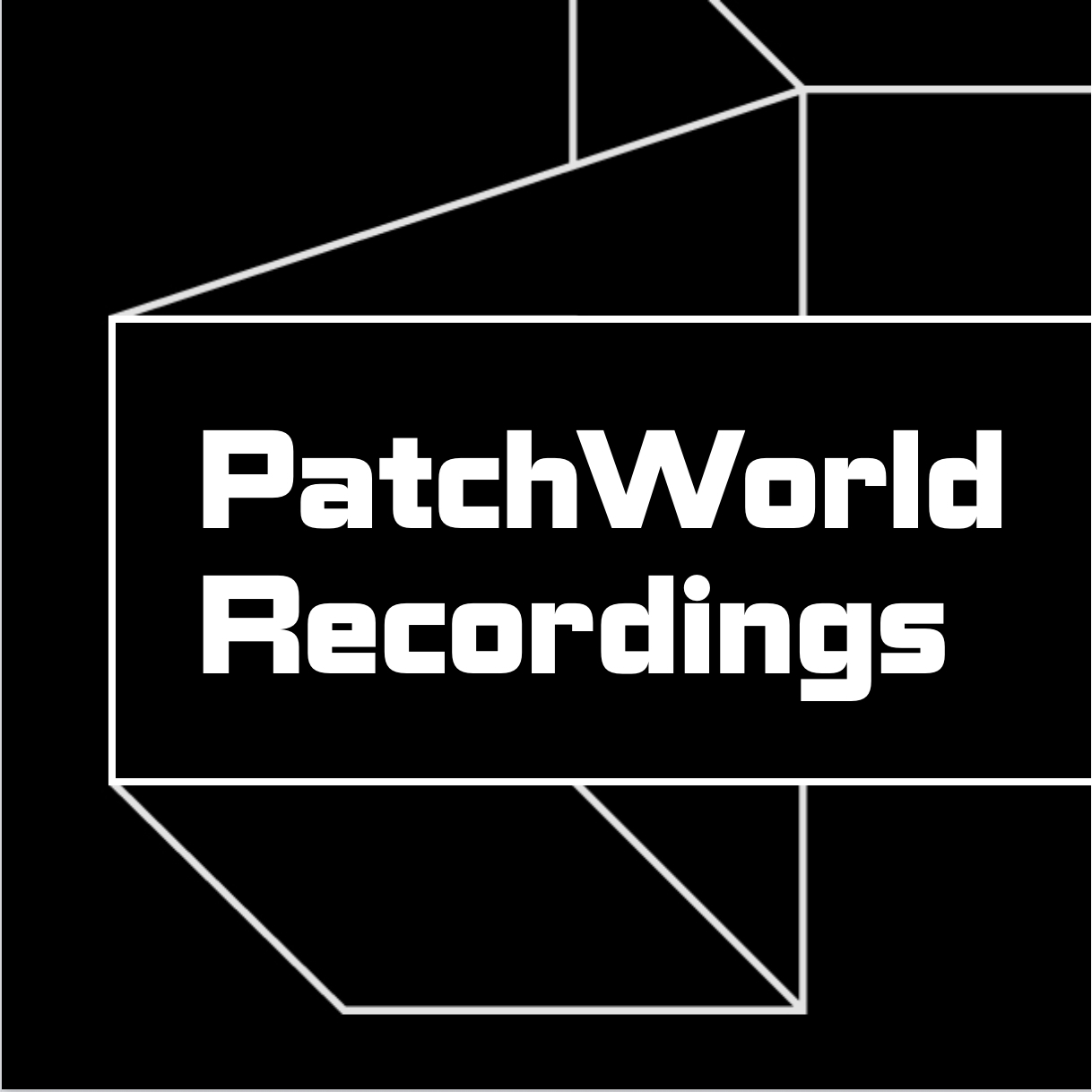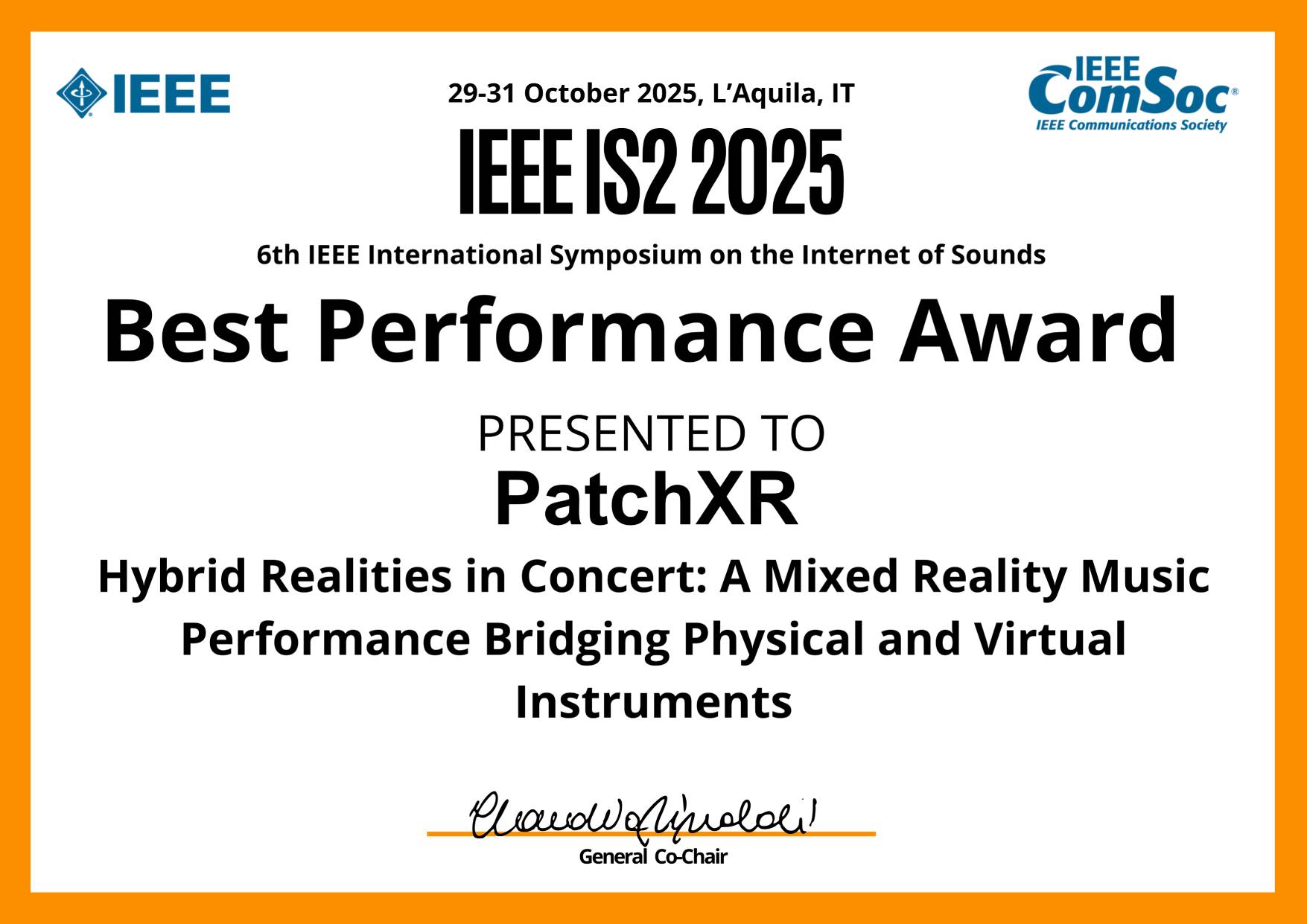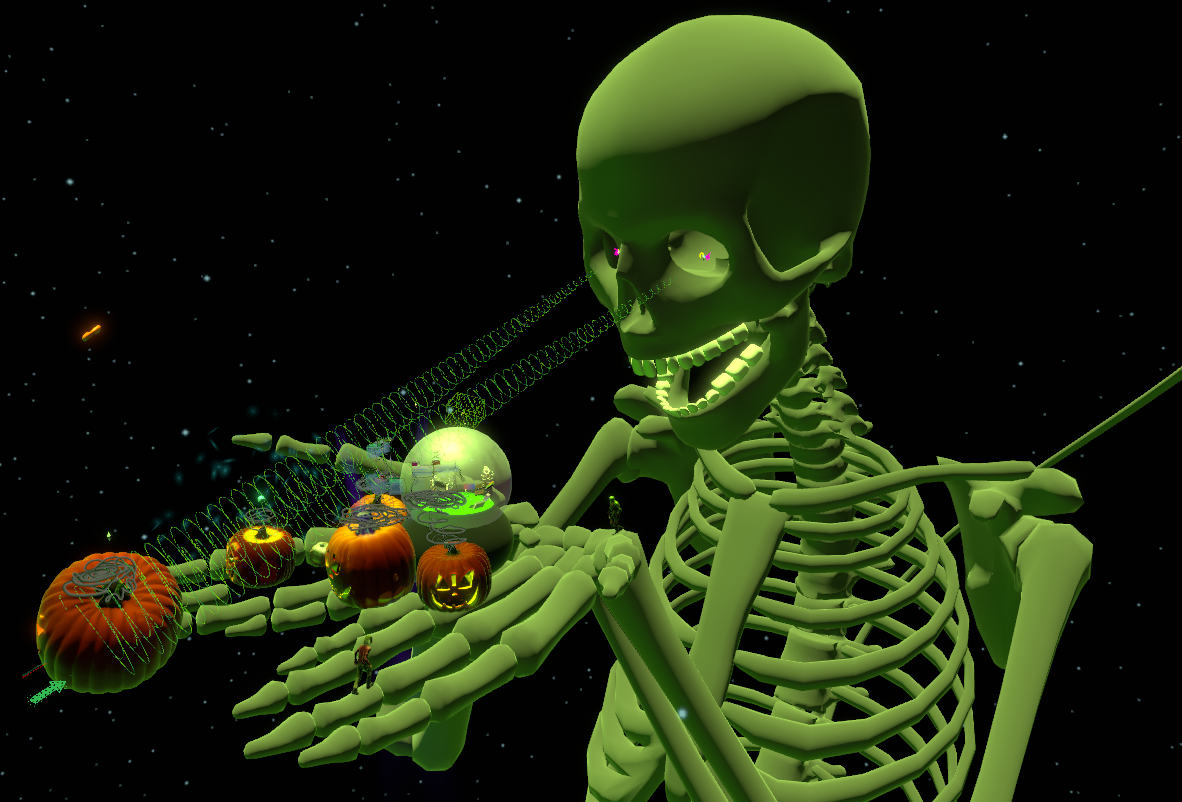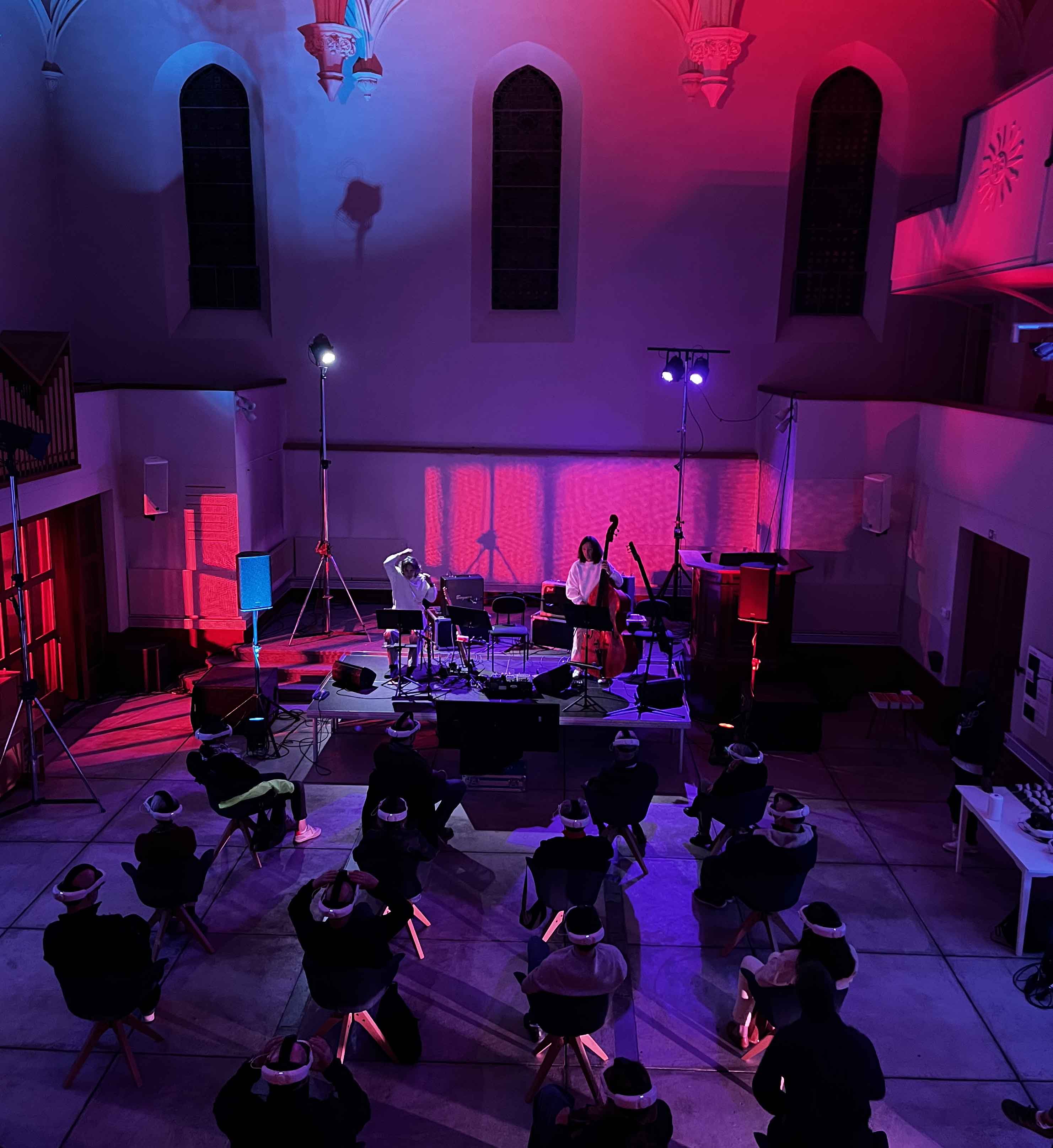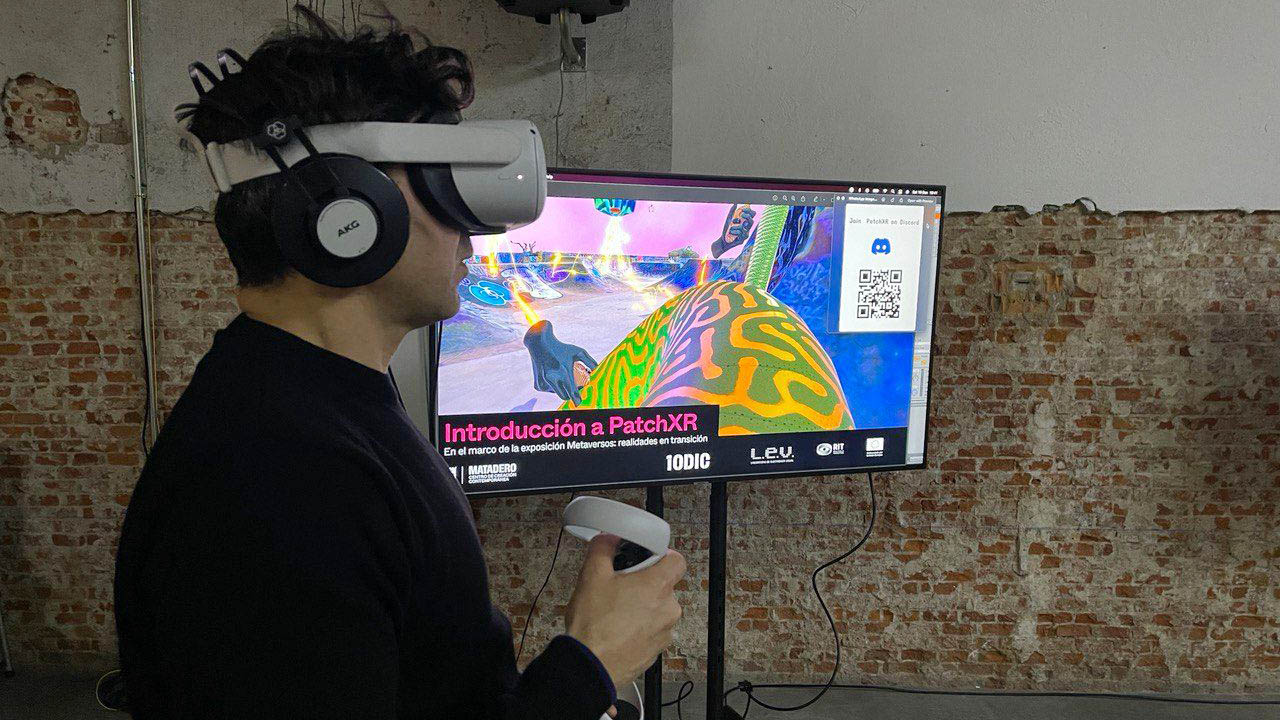
On December 10th, PatchXR held a workshop at the exhibition “Metaverses: Realities in Transition” at Matadero Madrid as part of the LEV Festival.
The hands-on workshop, led by Gad Barush Hinkis, product owner at PatchXR, provided an introduction to PatchWorld, our VR music platform to create and perform music in mixed and virtual reality.
With 10 metaquest2 devices, attendees with various backgrounds, including music producers and new media artists, Vr veterans and newcomers, were able to experiment with PatchWorld and discover the endless creative possibilities it offers for music production and live performance.
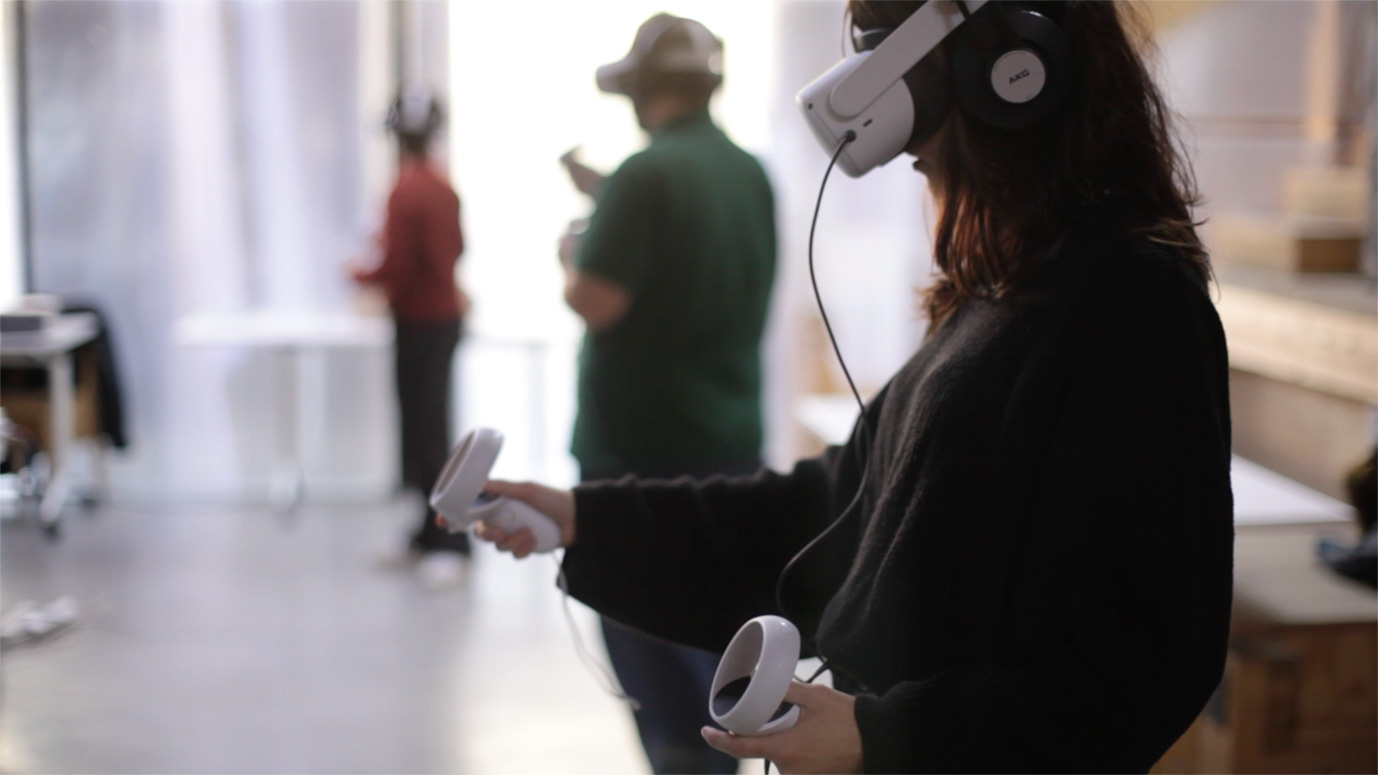
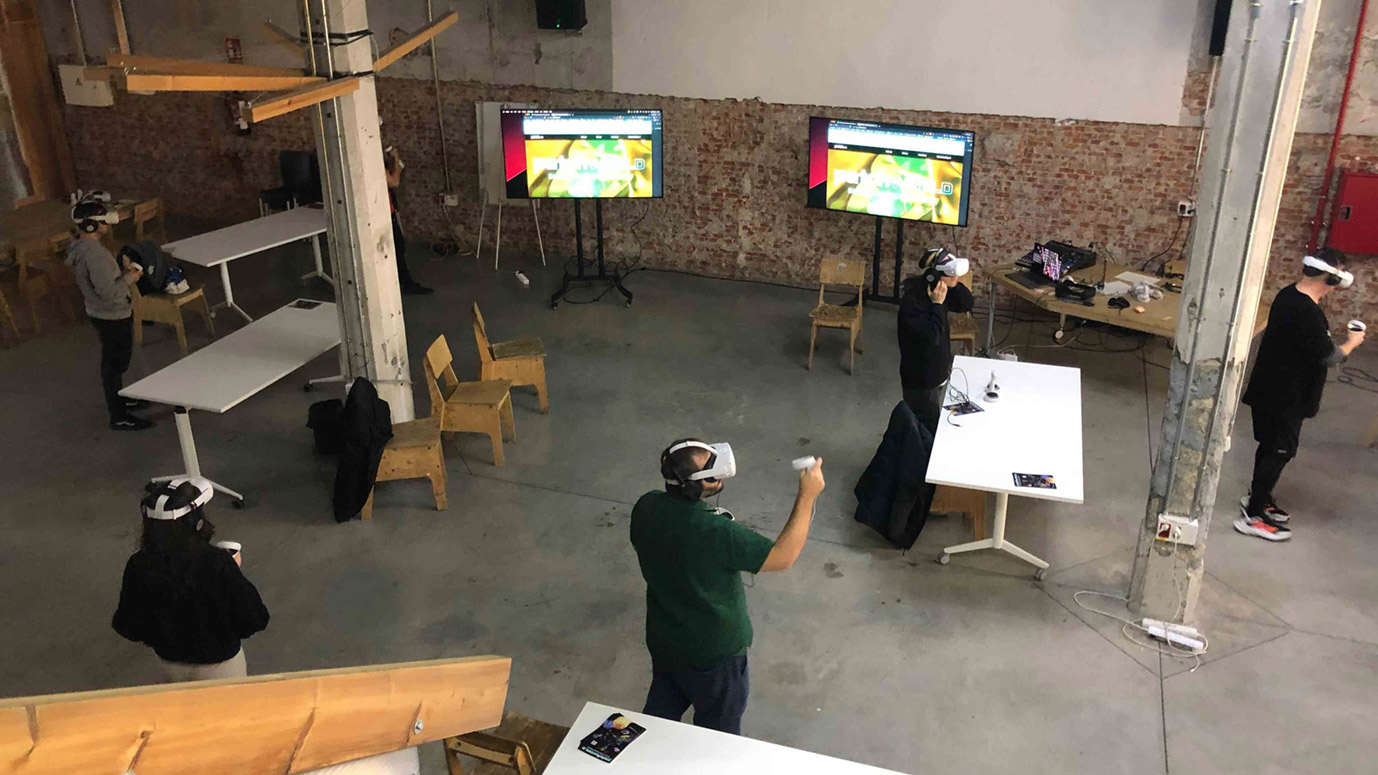
Check-out Gad setting-up the studio in colored mixed-reality
For this article, I interviewed two attendees of the workshop Let’s hear about their first experiences with PatchWorld and their thoughts on the role of immersive technology in the future of music creation:
Toño Cabanelas, Audiovisual Engineer, Madrid.
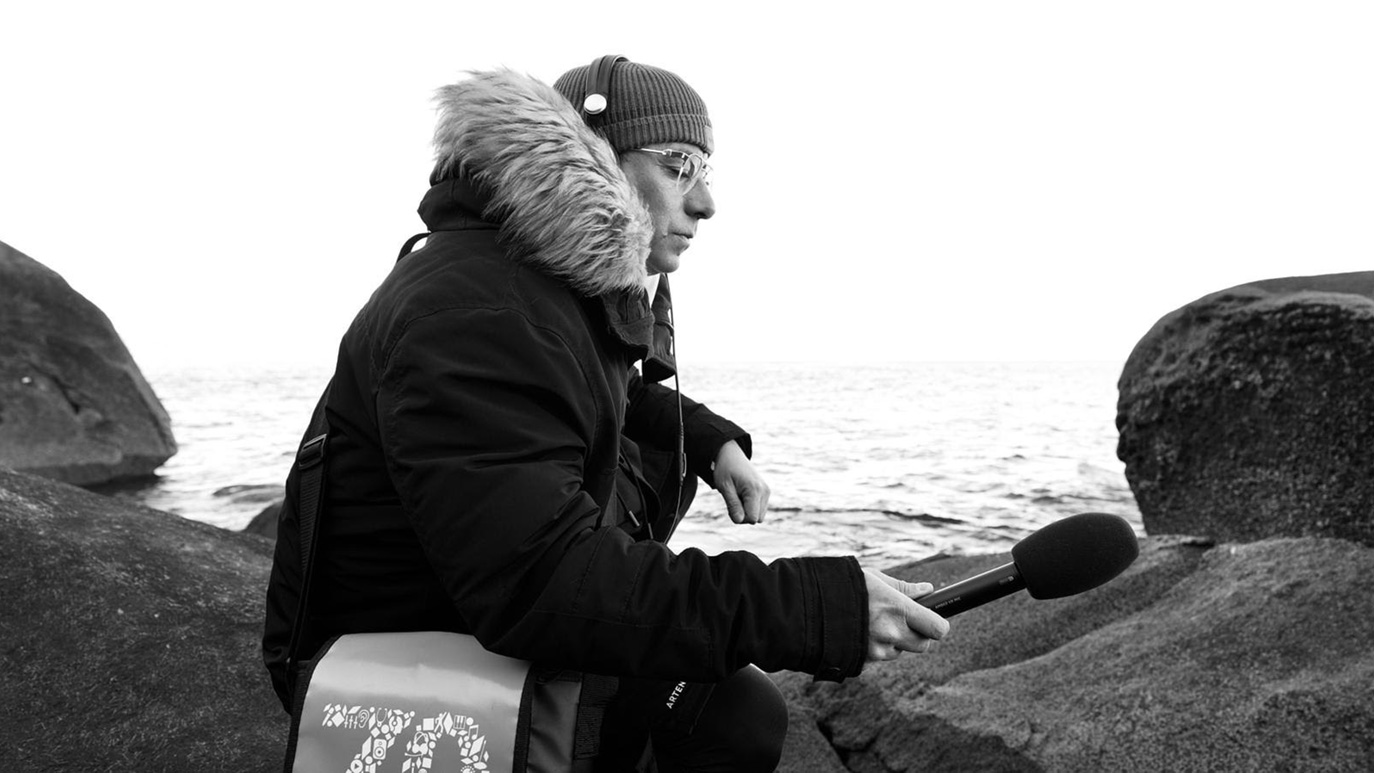
Hi Toño, thank you for joining the workshop and for sharing your thoughts with us. To start, can you tell us a little bit about yourself and your background ?
Toño: Hi, I am Audiovisual Engineer, expert in digital arts and 3D computing, specialized in VR, AR, XR, AI, tech arts professor and I am also the founder of Liveforevr, a VR concert platform.
I create audiovisual art and support other artists who investigate the intersection between cyber art and live performance. I collaborate with companies, institutions and individuals around the world in pursuit of one goal: to blend the digital with the physical. Our physical and digital worlds continually overlap. This is happening right now: the era of 3D immersion, mixed reality, metaverse, decentralization is born…
I use and teach Ableton, Max4Live, Touchdesigner, Unity 3D, Unreal Engine, Reaper, Logic, AI… microphones, synthesizers, cameras, 3D scanners, light and film projectors, modified speakers… etc.
Melo: What was your overall impression of PatchWorld after using it during the workshop? Were there any particular features or tools that stood out to you as particularly interesting or useful?
Toño: My impression was that in just a few months PatchWorld has become a very powerful environment and I consider it one of the most promising applications in the audio industry. At first, it is easy to perceive a tool like this as a kind of game, but in the workshop we could immediately see that the potential is impressive. In just a few hours of learning, profound sound and visual experiences can be achieved. Patchworld has a reasonable learning curve and is incredibly fun to use.
Watch Toño’s first patches in PatchWorld
My favourite features of PatchWorld are several. I think the spatial interface for creating patches and sound modules is awesome. I also find the spatial sound spectacular as well as being able to record what you do , not just the sound, but your own avatar action… that’s a bit sci-fi. I’m also very interested in the possibilities of integration and synchronization with real scenarios and tools, you have created a Max4Live for it which I think is a super powerful step. I also love the Mixed Reality with Passthrough that you have integrated, it’s great to see the virtual and the real mixed together. Finally, there’s the possibility to create multiplayer environments… It is still in beta,but THAT’s going to be a revolution.
Melo: As someone with a background in audiovisual engineering, how do you see PatchWorld fitting into your professional goals and interests?
Toño: In my case I find that PatchWorld fits like a glove in several of my professional projects. On an educational level it is a big step for any teacher like me. I teach musicians and technicians Max4live, Touch Designer, Unity 3D or Unreal Engine. I see PatchWorld as the future version of all these tools combined.
On a technical and artistic level I also think it has a huge potential. With my VR concert platform Liveforevr, we are dedicated to recording 3D concert experiences in VR and also creating meta-stages with VR glasses to share that content. Being able to use PatchWorld revolutionises the way we share immersive 3D sound art for audiences. We can organise e-raves, mixed reality live shows, real-time 3D recordings, hybridisation of live musicians with virtual musicians… it’s great.
I actually believe that the social or multiplayer part of PatchWorld can become something not only useful for the industry but also a radical change in the way people enjoy music, period.

Melo: You mentioned using Ableton, Max4Live, Touchdesigner, Unity 3D, Unreal Engine, Reaper, Logic, AI, synth…. How do you imagine integrating PatchWorld to your workflow? Do you see it as a complementary tool or as a standalone platform for music production and performance?
Toño: I use hybrid hardware and software tools: DAW’s, analogue synthesizers, real instruments, speakers, effects, etc. At the same time, my projects are AV, always mixing sound with visuals through cinema or laser projectors with Touchdesigner, Unity 3D or Max4Live. PatchWorld allows me to integrate a super powerful virtual sound environment (syncing Ableton or a mixer) based on synthesizers, samplers, drum machines or digital effects but with a real UX experience… the VR glasses allow you to feel like you are really there. It’s very easy to sync with any tool in the studio: by tempo, by Max4live or between several PatchWorlds at the same time. In my studio there is already a VR space to integrate PatchWorld into any project.
On the other hand, I see PatchWorld as a complementary tool and as an independent platform for music production and performance at the same time. For me it is both… I can integrate it seamlessly into my studio workflow and at the same time I can take the VR goggles into another space or a forest, take off my shoes, put my feet in the grass and create an amazing immersive music composition session without anything else.
Melo: Have you used any other VR creation tools in the past, and if so, how does PatchWorld compare?
Toño: Yes, I use a lot of VR tools to develop experiences, mostly based on 3D volumetric video capture, and teach VR in schools and universities. I have a lot of experience in this area, especially in the union that is happening, and that we are all looking for, between gaming, the audiovisual industry and art. PatchWorld is an incredible example of this union between the interactive, the audiovisual and the cultural. It looks like a video game but it is a musical tool and at the same time it is culture. Very few tools have managed to combine these characteristics at this time. This is the objective of web 3.0 for any project nowadays.
Melo: How do you see immersive technology, like PatchWorld, changing the way that we create and experience music in the future?
Toño: Immersive technologies like PatchWorld enable new and more interactive ways to create and experience music. This is something the music industry needs. The key to virtual (or mixed) reality is that you can live a digital experience in an immersive way. If you enjoy (or create) a music experience with your iPhone or PC you are interacting in 2D, from a screen… but you never go beyond that, there is a tremendous limit because there is no immersion. But with PatchWorld you can fully interact with the music in a virtual first-person environment and even shape it in real time.
This is a huge digital revolution that will produce entirely new musical experiences and allow for greater creative expression. The 2D screen is a barrier that is overcome with immersive technology and this will change everything. PatchWork is a tool that will blur the line between creators and audiences, putting them on the same experiential plane. It is a new and exciting road to travel.
Melo: As an educator, how do you see PatchWorld fitting into your classroom and curriculum? What potential do you see for the platform as a teaching and learning tool for sound and music?
Toño: As I mentioned above, it is a great educational opportunity. The subject I teach is called “Interactive Audio & XR”: mainly Max4live, Touch Designer, Unity 3D, Unreal Engine etc. PatchWorld not only fits in there but would be impossible to replace because it is a mix of all these tools: it has parts of Max4Live, a lot of Unity and Unreal and of course Touchdesigner. And with OSC we can mix everything: synthesizers, drum machines, real musicians in Live or Studio Recording… and so on.
Another huge potential I see is to be able to teach from the XR platform itself. If every student has a VR headset and we create a multiplayer “PatchWorld” with all of them, we could teach the class from the metaverse. That’s something incredible. And since you can record your avatar creating projects, that will also be spectacular tutorial material. Online classes are an interesting medium, but I think the future is immersive, as PatchWorld already proposes.
Melo: Is there anything else you’d like to add or share with other creators about why they should try PatchWorld?
Toño: Don’t wait any longer! It’s a new, powerful, fun musical experience… there is nothing like PatchWorld!
Melo: Thanx Tono can’t wait to see what you are patching
Latebris, music producer and audio engineer, Madrid
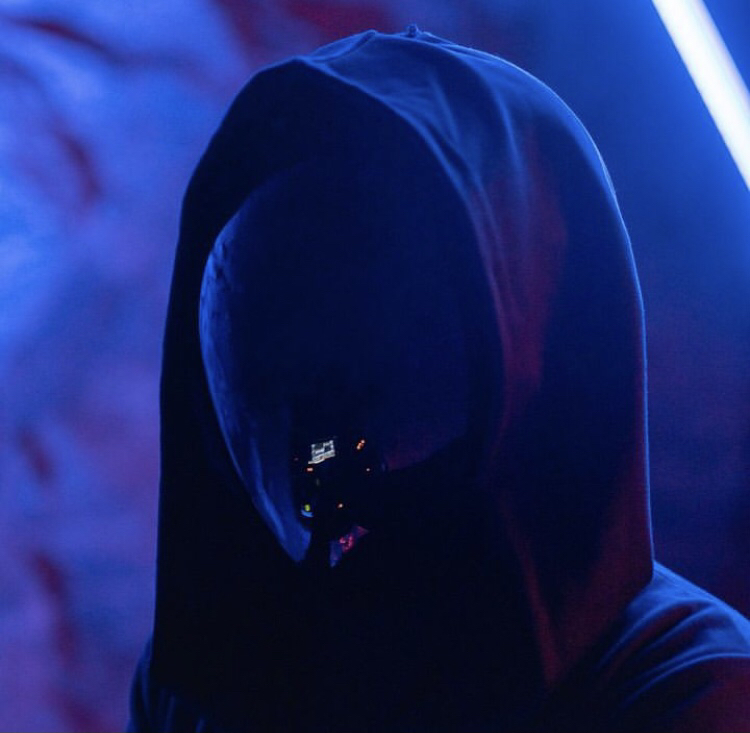
Melo: Hi Latebris, thank you for joining the PatchWorld workshop and for sharing your thoughts with us. To start, can you tell us a little bit about yourself and your background ?
Latebris: Of course, I am an electronic music artist inspired by the cyberpunk world who seeks to experiment with the most cutting-edge technologies such as artificial intelligence, metaverse, etc.. in order to expand the limits of creativity and music production. I am also a sound engineer and a synthesizers’ freak.
Melo: What was your overall impression of PatchWorld after using it during the workshop? Were there any particular features or tools that stood out to you as particularly interesting or useful?
Latebris: It was a very amusing discovery for me. I really appreciate that there are devices in PatchWorld for all levels of music production. I’m not an experienced VR user, and it was very easy to start making music with PatchWorld. As I gained confidence with VR, there were also many patching devices for experienced music producers with which I could create my own synths.
Melo: As someone with a background in sound engineering, how do you see PatchWorld fitting into your professional goals and interests?
Latebris: PatchWorld has a lot of potential. I think it’s a great environment to unleash creativity. You can add your own 3D spaces or create a mixed reality environment, and for me, it opens up many new music creation horizons because I can now create, for example, a mixed live setup with VR synths and hardware synths and this is amazing. I also really appreciate that PatchWorld has many programming synth options.
Melo: What other software or hardware do you use for your music creation and how do you imagine integrating PatchWorld to your workflow? Do you see it as a complementary tool or as a standalone platform for music production and performance?
Latebris: My main setup is formed by Ableton Live with some hardware synths and a modular synth. I like the existent Ableton compatible devices in PatchWorld but i think it needs more compatibility work. I would love a full compatibility between Ableton and PatchWorld and so i can control my modular synth with VR.
Melo: How do you see immersive technology, like PatchWorld, changing the way that we create and experience music in the future?
Latebris: I think this is just the beginning of many VR live sets that we will be able to enjoy in the future from anywhere in the world simultaneously as if you were right there. It will also be a great way to create music in spaces and with tools that don’t exist in real life and that will inspire artists in new ways. I am sure this will give rise to new musical genres.
Melo: Is there anything else you’d like to add or share with other creators about why they should try PatchWorld?
Latebris: I encourage all music producers, especially those who love live performance and synthesis to try PatchWorld because it is a the future of creation tools but already available today. It is amazing how you can create music in a much more tactile and sensory way, it’s like your VSTs become hardware in your own room. I confess that PatchWorld is responsible for me buying a pair of VR glasses.
Melo: Oh wow that’s amazing, and you have not been the only one, to get a headset just to be able to be able to have access to PatchWorld, Hopefully soon, there will be more music creator like you and Tono equipped with headset so we will see a lot more exciting content made in PatchWorld!

